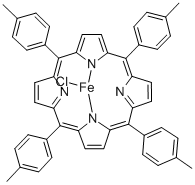
IdentificationPhysical DataSpectraRoute of Synthesis (ROS)Safety and HazardsOther Data
Identification
Product Namemeso-Tetratolylporphyrin-Fe(III)chloride CAS#: 19496-18-5IUPAC NameMolecular StructureCAS Registry Number 19496-18-5Synonyms21H,23H-Porphine, 5,10,15,20-tetrakis(4-methylphenyl)-, iron(3+) salt, hydrochloride (1:1:1) Chlorure 5,10,15,20-tétrakis(4-méthylphényl)porphine-21,23-diide de fer(3+) (1:1:1) Eisen(3+)chlorid-5,10,15,20-tetrakis(4-methylphenyl)porphin-21,23-diid (1:1:1) Iron(3+) chloride 5,10,15,20-tetrakis(4-methylphenyl)porphine-21,23-diide (1:1:1) 19496-18-5 5,10,15,20-Tetra(4-methylphenyl)-21H,23H-porphine iron(III) chlorideMESO-TETRATOLYLPORPHYRIN-FE(III)CHLORIDEMolecular FormulaC48H36ClFeN4Molecular Weight760.124
Physical Data
AppearanceDark blue or purple solid crystals
Melting Point, °C Solvent (Melting Point) 300dichloromethane
Spectra
Description (NMR Spectroscopy)Nucleus (NMR Spectroscopy)Solvents (NMR Spectroscopy)Temperature (NMR Spectroscopy), °C Spectrum1Hchloroform-d1Spectrum1H(2)H8-toluene-80Spectrum1HCDCl3-601HCDCl321
Description (IR Spectroscopy)Solvent (IR Spectroscopy)Comment (IR Spectroscopy)Spectrumpotassium bromideBandspotassium bromide14.85 - 54.85BandsKBr450 cm**-1 - 4000 cm**-1BandsKBrBandspotassium bromide300 cm**-1 - 1700 cm**-1
Description (UV/VIS Spectroscopy)Solvent (UV/VIS Spectroscopy)Comment (UV/VIS Spectroscopy)Absorption Maxima (UV/VIS), nmSpectrumdichloromethane381, 418, 511SpectrumSpectrumbenzene421dichloromethane418, 452, 511Band assignmentCHCl3418 nm - 695 nmBand assignmentbenzene418.4 nm - 685.6 nm
Route of Synthesis (ROS)
Route of Synthesis (ROS) of meso-Tetratolylporphyrin-Fe(III)chloride CAS# 19496-18-5
ConditionsYieldStage #1: 5,10,15,20-tetra(p-tolyl)porphyrin With iron(II) chloride tetrahydrate In N,N-dimethyl-formamide for 0.5h;Stage #2: With hydrogenchloride In water at 50 - 60℃;90.4%
Safety and Hazards
GHS Hazard StatementsNot ClassifiedFor more detailed information, please visit ECHA C&L website
Source: European Chemicals Agency (ECHA)License Note: Use of the information, documents and data from the ECHA website is subject to the terms and conditions of this Legal Notice, and subject to other binding limitations provided for under applicable law, the information, documents and data made available on the ECHA website may be reproduced, distributed and/or used, totally or in part, for non-commercial purposes provided that ECHA is acknowledged as the source: “Source: European Chemicals Agency, http://echa.europa.eu/”. Such acknowledgement must be included in each copy of the material. ECHA permits and encourages organisations and individuals to create links to the ECHA website under the following cumulative conditions: Links can only be made to webpages that provide a link to the Legal Notice page.License URL: https://echa.europa.eu/web/guest/legal-noticeRecord Name: (1-Cyano-2-ethoxy-2-oxoethylidenaminooxy)dimethylamino-morpholino-carbenium hexafluorophosphateURL: https://echa.europa.eu/information-on-chemicals/cl-inventory-database/-/discli/details/213446Description: The information provided here is aggregated from the “Notified classification and labelling” from ECHA’s C&L Inventory. Read more: https://echa.europa.eu/information-on-chemicals/cl-inventory-database
Other Data
TransportationUnder room temperature away from light.HS CodeStorageUnder the room temperature and away from lightShelf Life1 yearMarket Price
DruglikenessLipinski rules componentMolecular Weight760.141logP17.372HBA4HBD0Matching Lipinski Rules2Veber rules componentPolar Surface Area (PSA)19.72Rotatable Bond (RotB)7Matching Veber Rules2
https://www.chemwhat.com/meso-tetratolylporphyrin-feiiichloride-cas-19496-18-5/
Comments
Post a Comment